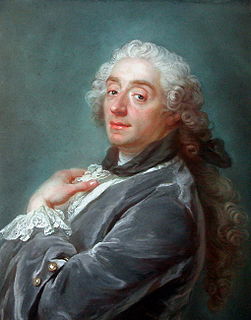
François Boucher was a French painter, draughtsman and etcher, who worked in the Rococo style. Boucher is known for his idyllic and voluptuous paintings on classical themes, decorative allegories, and pastoral scenes. He was perhaps the most celebrated painter and decorative artist of the 18th century.

William Holman Hunt was an English painter and one of the founders of the Pre-Raphaelite Brotherhood. His paintings were notable for their great attention to detail, vivid colour, and elaborate symbolism. These features were influenced by the writings of John Ruskin and Thomas Carlyle, according to whom the world itself should be read as a system of visual signs. For Hunt it was the duty of the artist to reveal the correspondence between sign and fact. Of all the members of the Pre-Raphaelite Brotherhood, Hunt remained most true to their ideals throughout his career. He was always keen to maximise the popular appeal and public visibility of his works.

The Roaring Forties are strong westerly winds found in the Southern Hemisphere, generally between the latitudes of 40°S and 50°S. The strong west-to-east air currents are caused by the combination of air being displaced from the Equator towards the South Pole, the Earth's rotation, and the scarcity of landmasses to serve as windbreaks at those latitudes.

A mantua is an article of women's clothing worn in the late 17th century and 18th century. Originally a loose gown, the later mantua was an overgown or robe typically worn over stays, stomacher and a co-ordinating petticoat.

Charles Cottet was a French painter, born at Le Puy-en-Velay and dead in Paris. A famed post-impressionist, Cottet is known for his dark, evocative painting of rural Brittany and seascapes. He led a school of painters known as the Bande noire or "Nubians" group, and was friends with such artists as Auguste Rodin.
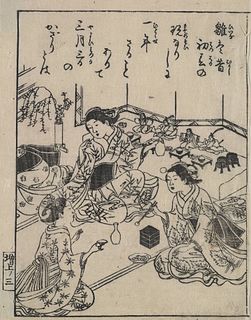
Nishikawa Sukenobu, often called simply "Sukenobu", was a Japanese printmaker from Kyoto. He was unusual for an ukiyo-e artist, as he was based in the imperial capital of Kyoto. He did prints of actors, but gained note for his works concerning women. His Hyakunin joro shinasadame, in two volumes published in 1723, depicted women of all classes, from the empress to prostitutes, and received favorable results.

The Tomb of the Roaring Lions is an archaeological site at the ancient city of Veii, Italy. It is best known for its well-preserved fresco paintings of four feline-like creatures, believed by archaeologists to depict lions. The tomb is believed to be one of the oldest painted tombs in the western Mediterranean, dating back to 690 BCE. The discovery of the Tomb allowed archaeologists a greater insight into funerary practices amongst the Etruscan people, while providing insight into art movements around this period of time. The fresco paintings on the wall of the tomb are a product of advances in trade that allowed artists in Veii to be exposed to art making practices and styles of drawing originating from different cultures, in particular geometric art movements in Greece. The lions were originally assumed to be caricatures of lions – created by artists who had most likely never seen the real animal in flesh before.
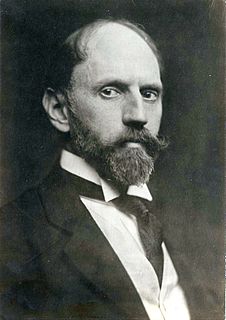
Frederick Judd Waugh was an American artist, primarily known as a marine artist. During World War I, he designed ship camouflage for the U.S. Navy, under the direction of Everett L. Warner.
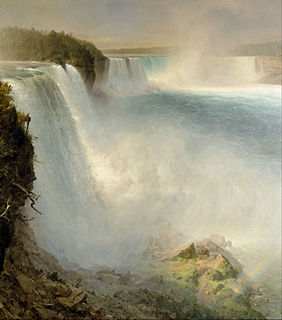
Niagara Falls, from the American Side is a painting by the American artist Frederic Edwin Church (1826–1900). Completed in 1867, it is based on preliminary sketches made by the artist at Niagara Falls and on a sepia photograph. It is Church's largest painting. The painting is now in the collection of the Scottish National Gallery. Church was a leading member of the Hudson River School of painters.
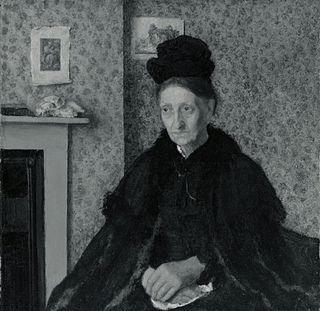
Mrs. Atkinson is a painting (portrait) by Gwen John. It is in the collection of the Metropolitan Museum of Art.

Arab Woman is a watercolor painting by John Singer Sargent. Completed in either the late 19th or early 20th century, the painting is currently in the collection of the Metropolitan Museum of Art.

Wild Weather is an oil on masonite painting by American artist Frederick Judd Waugh. The work depicts waves crashing over stark rock formations, and along with Roaring Forties is one of two seascapes by Waugh on display at the Metropolitan Museum of Art. Waugh recorded his palette for his marine paintings as: permalba white, the cadmiums, alizarin, cerulean blue, cobalt blue, ultramarine blue, viridian, raw sienna, burnt sienna and ivory black.

The Calm Sea is an 1869 painting by Gustave Courbet. Done in oil on canvas, the seascape depicts a beach on the Normandy coast stretched out before the English Channel. The painting is in the collection of the Metropolitan Museum of Art.

Moonlight, Wood Island Light is a late 19th-century oil painting by American artist Winslow Homer. The painting is currently in the collection of the Metropolitan Museum of Art in New York.
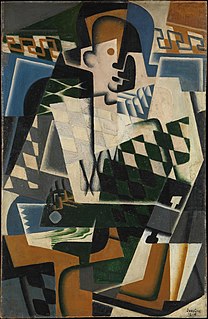
Harlequin with a Guitar is an early 20th century painting by Spanish cubist Juan Gris. Done in oil on panel, the work is in the collection of the Metropolitan Museum of Art.

The Farm at Les Collettes, Cagnes is an early 20th century oil on canvas painting by French artist Pierre-Auguste Renoir. The work is in the collection of the Metropolitan Museum of Art.

Boating is an 1874 painting by French artist Édouard Manet in the collection of the Metropolitan Museum of Art, New York.

Cypresses is a late 19th-century painting by Dutch artist Vincent van Gogh painted around June 1889. Done in oil on canvas, the painting depicts a pair of cypress trees in the French countryside. The work is currently on display in the Metropolitan Museum of Art.

Louise Amélie Landré was a French painter. She studied under Jean Hubert and Charles Chaplin and made her debut at the Salon in 1876. In 1885, she became a member of the Société des Artistes Français. Three of her 1916 watercolors showing the lives of soldiers are in the collection of the Metropolitan Museum of Art.



















